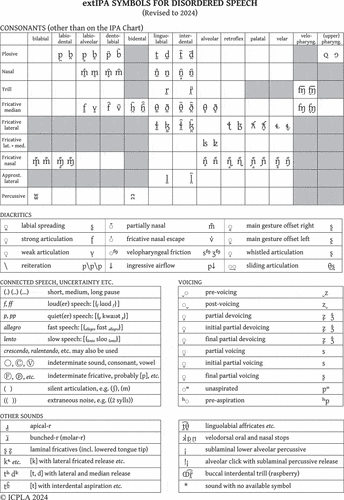ABSTRACT
This short note outlines changes to three of the diacritics on the extIPA chart and provides an updated version of the entire chart.
Following notification by some users, it was suggested that some extIPA diacritics needed to be altered. The reasons include: difficulty in distinguishing a diacritic from a similar one, use of the diacritic to denote something else in other phonetic work, and lack of clarity in the description of the diacritic.
Following an agreement by the Committee of the International Clinical Phonetics and Linguistics Association (14 May 2024), the changes discussed below have been approved.
The extIPA diacritics previously approved are shown in .
The changes approved at the 14 May 2024 meeting, and the reasons for these changes are as follows.
Denasal, partial nasal. This diacritic should be retained, but the descriptor should be altered to read ‘partially denasal’ and the second example in parentheses removed. Fully denasal sounds are, by definition, oral, therefore the diacritic is only of use to denote partial loss of nasalisation as extIPA symbols have always eschewed transcription by target (e.g. Ball, Citation2008, Citation2021). This change was suggested by the current author.
Fricative nasal escape. The diacritic here is very difficult to distinguish from the previous one. Kirk Miller (personal communication, 1 November 2023) suggested altering it to ‘vertical tilde’ as this is clearly different but retains the link to the tilde: [v̾].
Velopharyngeal friction. The double tilde is problematic firstly because it is difficult to distinguish from the single tilde in smaller type sizes, and secondly because it has been used elsewhere to mean strong nasalisation (e.g. Kelly & Local, Citation1989). Following IPA usage, this has been replaced by a superscript velopharyngeal fricative symbol: [sʩ]. Kirk Miller (personal communication, 1 November 2023) also suggested adding the superscript trilled velopharyngeal fricative to allow the transcription of accompanying trilling: [s
 ]. This would be difficult to fit into the current grid, however, and should await a more thorough revision of the chart.
]. This would be difficult to fit into the current grid, however, and should await a more thorough revision of the chart.
The revised Diacritics section would then be as in .
shows the entire extIPA chart with the changed diacritic section. This version should be used from now on.
Disclosure statement
No potential conflict of interest was reported by the author.
References
- Ball, M. J. (2008). Transcribing disordered speech: By target or by production? Clinical Linguistics & Phonetics, 22(10–11), 864–870. https://doi.org/10.1080/02699200802172757
- Ball, M. J. (2021). Transcribing: By target or by realization? In M. J. Ball (Ed.), Manual of clinical phonetics (pp. 187–192). Routledge.
- Kelly, J., & Local, J. (1989). Doing phonology: Observing, recording, interpreting. Manchester University Press.



